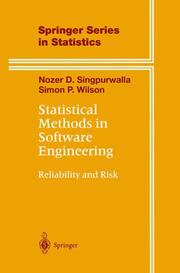-
Zusatztext
-
Inhaltsangabe1 Introduction and Overview.- 1.1 What is Software Engineering?.- 1.2 Uncertainty in Software Production.- 1.2.1 The Software Development Process.- 1.2.2 Sources of Uncertainty in the Development Process.- 1.3 The Quantification of Uncertainty.- 1.3.1 Probability as an Approach for Quantifying Uncertainty.- 1.3.2 Interpretations of Probability.- 1.3.3 Interpreting Probabilities in Software Engineering.- 1.4 The Role of Statistical Methods in Software Engineering.- 1.5 Chapter Summary.- 2 Foundational Issues: Probability and Reliability.- 2.0 Preamble.- 2.1 The Calculus of Probability.- 2.1.1 Notation and Preliminaries.- 2.1.2 Conditional Probabilities and Conditional Independence.- 2.1.3 The Calculus of Probability.- 2.1.4 The Law of Total Probability, Bayes' Law, and the Likelihood Function.- 2.1.5 The Notion of Exchangeability.- 2.2 Probability Models and Their Parameters.- 2.2.1 What is a Software Reliability Model?.- 2.2.2 Some Commonly Used Probability Models.- 2.2.3 Moments of Probability Distributions and Expectation of Random Variables.- 2.2.4 Moments of Probability Models: The Mean Time to Failure.- 2.3 Point Processes and Counting Process Models.- 2.3.1 The Nonhomogeneous Poisson Process Model.- 2.3.2 The Homogeneous Poisson Process Model.- 2.3.3 Generalizations of the Point Process Model.- 2.4 Fundamentals of Reliability.- 2.4.1 The Notion of a Failure Rate Function.- 2.4.2 Some Commonly Used Model Failure Rates.- 2.4.3 Covariates in the Failure Rate Function.- 2.4.4 The Concatenated Failure Rate Function.- 2.5 Chapter Summary.- Exercises for Chapter 2.- 3 Models for Measuring Software Reliability.- 3.1 Background: The Failure of Software.- 3.1.1 The Software Failure Process and Its Associated Randomness.- 3.1.2 Classification of Software Reliability Models.- 3.2 Models Based on the Concatenated Failure Rate Function.- 3.2.1 The Failure Rate of Software.- 3.2.2 The Model of Jelinski and Moranda (1972).- 3.2.3 Extensions and Generalizations of the Model by Jelinski and Moranda.- 3.2.4 Hierarchical Bayesian Reliability Growth Models.- 3.3 Models Based on Failure Counts.- 3.3.1 Time Dependent Error Detection Models.- 3.4 Models Based on Times Between Failures.- 3.4.1 The Random Coefficient Autoregressive Process Model.- 3.4.2 A Non-Gaussian Kalman Filter Model.- 3.5 Unification of Software Reliability Models.- 3.5.1 Unification via the Bayesian Paradigm.- 3.5.2 Unification via Self-Exciting Point Process Models.- 3.5.3 Other Approaches to Unification.- 3.6 An Adaptive Concatenated Failure Rate Model.- 3.6.1 The Model and Its Motivation.- 3.6.2 Properties of the Model and Interpretation of Model Parameters.- 3.7 Chapter Summary.- Exercises for Chapter 3.- 4 Statistical Analysis of Software Failure Data.- 4.1 Background: The Role of Failure Data.- 4.2 Bayesian Inference, Predictive Distributions, and Maximization of Likelihood.- 4.2.1 Bayesian Inference and Prediction.- 4.2.2 The Method of Maximum Likelihood.- 4.2.3 Application: Inference and Prediction Using Jelinski and Moranda's Model.- 4.2.4 Application: Inference and Prediction Under an Error Detection Model.- 4.3 Specification of Prior Distributions.- 4.3.1 Standard of Reference-Noninformative Priors.- 4.3.2 Subjective Priors Based on Elicitation of Specialist Knowledge.- 4.3.3 Extensions of the Elicitation Model.- 4.3.4 Example: Eliciting Priors for the Logarithmic-Poisson Model.- 4.3.5 Application: Failure Prediction Using Logarithmic-Poisson Model.- 4.4 Inference and Prediction Using a Hierarchical Model.- 4.4.1 Application to NTDS Data: Assessing Reliability Growth.- 4.5 Inference and Predictions Using Dynamic Models.- 4.5.1 Inference for the Random Coefficient Exchangeable Model.- 4.5.2 Inference for the Adaptive Kalman Filter Model.- 4.5.3 Inference for the Non-Gaussian Kalman Filter Model.- 4.6 Prequential Prediction, Bayes Factors, and Model Comparison.- 4.6.1 Prequential Likelihoods and Prequential Prediction.- 4.6.2 Bayes' Factors and Model Averaging.- 4.
-
-
Kurztext
-
Aims to establish a framework for dealing with uncertainties in software engineering, and for using quantitative measures for decision making in this context. This book brings in perspective the large body of work having statistical content that is relevant to software engineering.
-
Detailansicht
Statistical Methods in Software Engineering
Reliability and Risk, Springer Series in Statistics
ISBN/EAN: 9780387988238
Umbreit-Nr.: 1656596
Sprache:
Englisch
Umfang: xiv, 297 S., 55 Fotos
Format in cm:
Einband:
gebundenes Buch
Erschienen am 05.08.1999
Auflage: 1/1999


